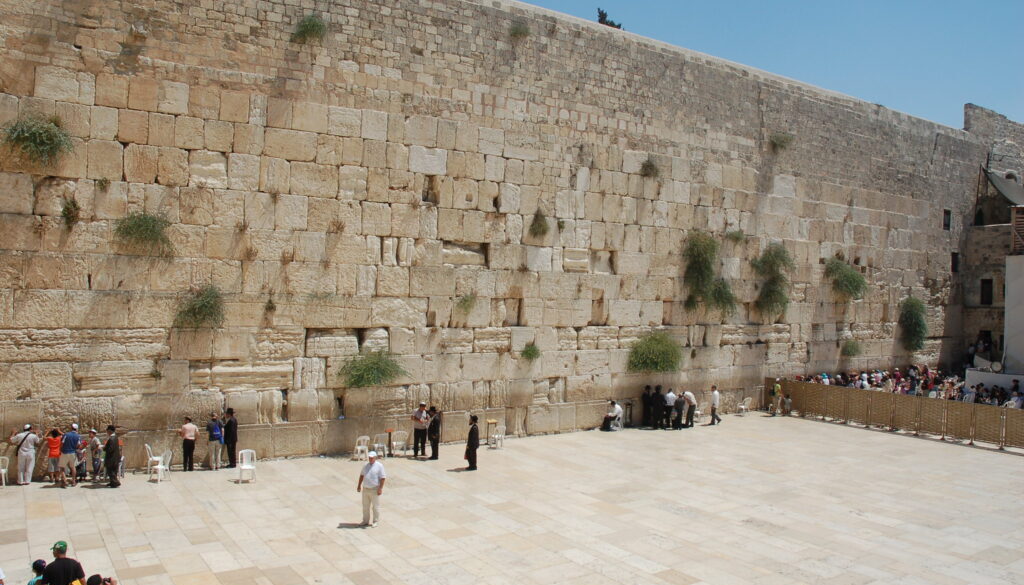Four Cubits
‘Ein laKadosh Baruch Hu b’olamo ela arbah amot shel Halakhah’, is an oft-cited maxim of the Talmud. ‘In God’s world, the Holy Blessed One only possesses the four cubits of Halakhah.’ (Bavli Eruvin 48a et al.)
Why does God only have the four cubits of Halakhah?
This maxim is often given in context of the destruction of the Temple. In the wake of the traumatic events of the ‘Churban’, the Rabbis scrambled to build a new Judaism. Gone was the pageantry and ceremony of a Temple-based covenantal religion where the rules of engagement and the universe of obligation were clear. The Temple aspired to such grandeur that even Gentile tourists would visit it in the ancient world. In reality, of course, the politics and theologies of the Temple were far more fraught, but we can imagine that there was splendor and mythic connection associated with its rites.
Then the Temple was no more.
We may know the story of Rabbi Yochanan ben Zakkai, one of the Mishnah’s first sages, who was smuggled out of a burning Jerusalem in a coffin. ‘Give me Yavneh and its sages’, he famously stated, and settling in Yavneh, a non-descript town of no particular note, he built a Beit Midrash, giving rise to the ‘Rabbinic Revolution’ and to Judaism as we still recognize today. An act of desperation in the face of collective national trauma became a rebellion of hope. Yochanan ben Zakkai knew not just the hopelessness of the four cubits of Halakhah but also their empowering charge.
For a population in lockdown, self-quarantining (whether voluntarily or through a Governor’s order), there is wisdom in this notion of the four cubits. Four paces. A few square feet of space around us, between us. This is our dominion. The paradox of Halakhah – of Jewish law (or as we could translate it, of ‘the Path’) – is that it is both constraining and liberating. It disciplines us and pushes our creativity. It limits us and it sets us free. It is in the ‘smallness’ of Halakhah that we find control: how we choose to navigate Shabbat, the dietary laws, the Festivals, prayer, tzedakah, ethical questions, sacred speech and social interaction. This smallness is not meant to be reductive; but expansive – to invite us into greatness. This is the paradox of Halakhah.
There are a number of ideological and theological retorts that one could counter Halakhic observance with. For as soon as the Rabbis engaged in their Halakhic project, they have faced opposition and critique. Whether it was Karaites in the 8thcentury, the early Reformers in the 19th century or the notion of post-Halakhic Judaism in our own time. These systemic and moral critiques are healthy—Judaism needs them. We are all at liberty to shape our own complex, meandering, inconsistent or perhaps limited relationship to Halakhah. At the same time, I wonder, can we learn something from this strangely powerful image of four cubits of Halakhah for our times?
When life is comfortable, it is easy to disregard or to push aside the merits of such spiritual discipline. Now, however, our world depends on discipline. Pirke Avot famously states in the words of Ben Zoma ‘Who is strong? One who governs their own inclination.’ (Pirke Avot 4:1) We are called to ‘lehitgaber et yitzro’ at every turn during this pandemic. We are called to socially distance, to delay our normal gratifications, to disappoint children and to isolate our elders and vulnerable populations. We cannot work, learn and play as usual. Innocent pleasures such as congregating in restaurants, shops and parks become potentially deadly ones. While the joke has been made on social media that ‘we can save lives by sitting on our couch’, we can strive to imbue the sentiment with greater k’dushah (holiness). One of the myriad lessons of this crisis is the importance of what constitutes the inner mechanism of Halakhah: boundaries and trust.
The underlying thrust of this week’s Torah portion, Parashat Shemini is all about what four cubits of our world we choose to remain in and what the consequences are when we do not. The only answers to the moral questions of Shemini are boundaries and trust, and it could be argued that it is these things that unify the seemingly disparate themes of the portion: the deaths of Nadav and Avihu and the giving of the dietary laws. I do not want to delve into the why’s and how’s of Nadav and Avihu’s fate. Instead, I want to focus on a seemingly innocuous verse a little later on. Aaron has just had to contend with the unexpected death of his two eldest sons and their corpses have been removed and placed outside the camp. Immediately, and perhaps counter-intuitively, Aaron and his remaining sons, Elazar and Itamar are given instructions regarding the meal offering. Then, the Torah tells us the following: ‘V’achaltem otah bemakom kodesh’ – ‘and you shall eat it [the meal offering] in the sacred place [precinct]’ (Lev. 10:13) In a sense, the Priests are, at least in this instance, relegated to their own ‘arba amot’, ‘four cubits’. Restrictions are placed upon them in contrast to the defiance of Nadav and Avihu. Shortly after, God reveals the dietary laws to Moses and Aaron. Concluding the laws of kashrut given in chapter 11 is a powerful statement: ‘Lehavdil bein hatame uvein hatahor’ – ‘to distinguish between the impure and the pure.’ (Lev. 11:47) This is the very discernment and discipline that arguably, Nadav and Avihu did not possess and that we are required to internalize. That this pertains to food may be the beginning of this sacred practice, not its end.
As many of you may know, I grew up consuming every imaginable treif (non-kosher) food under the sun. Buttery lobster, hearty ostrich steak, the finest and most flavorful cured hams this side of Heaven. When I started keeping kosher almost two decades ago and started cutting out pork and then shellfish, I was struck by how visceral my response was. It was hard. I have distinct memories of salivating before a tray of ham sandwiches at the deli counter where I worked. It took every scrap of determination I could muster to not give in to what was now a temptation and what had once been normal. Over the years, I learned to say no. No to pork, shellfish, meat and dairy combined and so forth. Interestingly, as I mustered the discipline to ‘conquer my impulses’ in the area of food, I noticed that I was also able to say no to other areas in my life where I felt morally compelled to say no. Kashrut was the beginning of a great journey on which I still find myself on. Halakha – the Path.
Rabbi Joseph B. Soloveitchik, a famous 20th century Modern Orthodox philosopher, wrote in his seminal book, ‘Halakhic Man’ [Ish ha’Halakhah]:
“Halakhic man, well furnished with rules, judgments, and fundamental principles, draws near the world with an a priori relation. His approach begins with an ideal creation and concludes with a real one… The essence of the Halakhah… consists in creating an ideal world and cognizing the relationship between that ideal world and our concrete environment.”
We are currently existing in our metaphorical four cubits. This can be a source of distress or a source of meaning. The purpose of this sermon is not to entice people to observe Jewish Law in any particular way. The purpose is for us to dig deeper; to examine what the discipline of restraint and sanctification can give us in a time where enacting meticulous separations is not just a matter of spiritual edification but of saving actual lives. Our very being intersects on that fulcrum of the ideal world and our concrete environment. Do we socially distance, yes or no? Wear a mask in public, yes or no? Wash our hands meticulously, yes or no? Like Jewish observance, many of these practices can seem strange and feel embarrassing. Still, here we are, invited to much deeper and richer contemplation, charged to conduct ourselves with discipline and solidarity, to find contentment and inner fortitude within. Perhaps these mechanisms of necessity can teach us about practices of sanctification, so that we can create out of our four cubits, a ‘makom kodesh’, a holy place.




